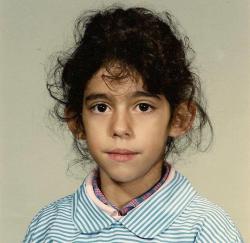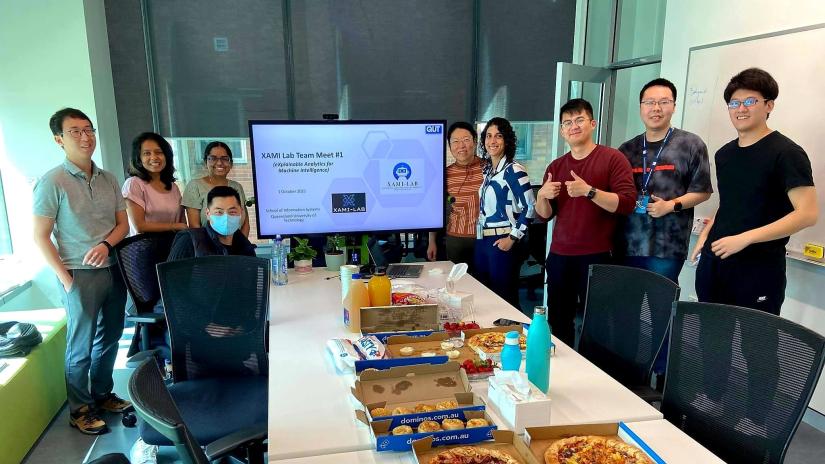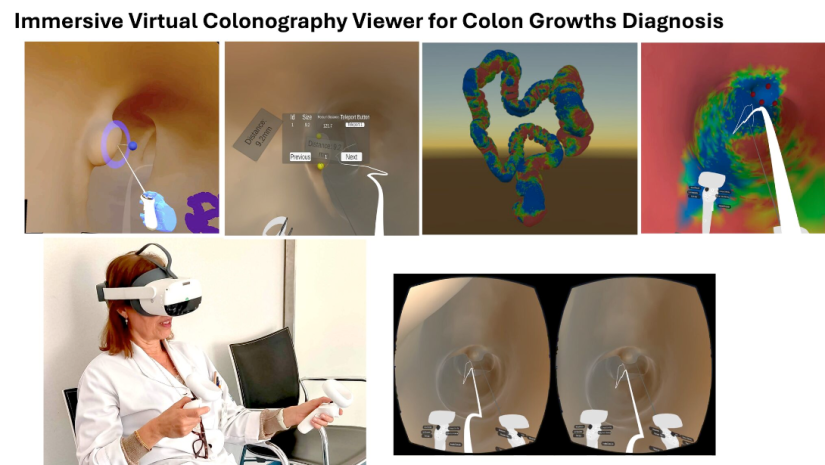Catarina is HTI's Lead Research Scientist for the Thrive program. She stars in our first HTI Staff Spotlight.
We know Catarina as the Lead Research Scientist for the Thrive: Finishing School Well program, developing algorithms for causal discovery and working with probabilistic models to understand factors that impact students’ school attendance.
After hours, she is the UNESCO Co-Chair in AI and Extended Reality, working to build AI systems for remote medical assistance and training – including for virtual colonoscopies. She also continues her connection with QUT’s Explainable AI Lab, which she founded, and enjoys giving back to her community.
Welcome to our first HTI Staff Spotlight.

Catarina (in yellow jacket) with colleagues presenting at the QUT Women in Research Showcase 2021. Photo supplied by Catarina Pinto Moreira
Beginnings in Portugal
Catarina’s path to HTI began in her home country of Portugal. Despite her family coming from a modest background, Catarina’s mother encouraged her children to study.

Catarina, aged 6
“My grandmother was a fisherwoman. My father used to work at the police, he even battled in the colonial war in Portugal. They lived throughout the dictatorship period, [where the culture was] very traditional Catholic families,” Catarina said.
Catarina was on track to study pharmacy, which was an acceptable career for a woman in Portugal at the time. “But in the last moment, I don't know what happened because I never heard about computer science and engineering before - and then I was with the university papers in my hand to apply and I said, I'm gonna put this, this and this - all Computer Science and Engineering degrees.”
Catarina was accepted to Instituto Superior Técnico at the University of Lisbon where she was one of only four women in her first year. She went on to do her master's in information systems and AI, and her top results steered her away from a career in industry to a PhD thesis in quantum mechanics’ application to human decision-making, where she was awarded summa cum laude, the highest honor for a PhD.
Path to Australia
She was offered a tenured position at Leicester University in 2017, where she stayed for two years before she was contacted by renowned quantum cognition academic Prof. Peter Bruza to join his team at Queensland University of Technology (QUT).
“It was a big decision because I'm European. I mean, my safe zone is when I'm in Europe. In the European Union, any country you feel at home... If something was wrong, I'm two hours and 50 euros from home.
“Australia was a one-day trip!”
Catarina ultimately made the big move to QUT and went on to co-found the Explainable Analytics for Machine Intelligence (XAMI) Lab, supported by another female academic who recognised Catarina’s talent and shared the same passion for AI.

Catarina (fourth from right) and colleagues at first meeting of XAMI Lab. Photo supplied by Catarina Pinto Moreira
UNESCO Co-Chair in AI and XR
It was during this time that Catarina became interested in the use of AI in health care settings. Together with Prof. Joaquim Jorge, she successfully pitched to become the UNESCO co-chair in AI and Virtual and Extended Reality, a project she does after the Thrive workday is finished.
In this role, Catarina is working to reduce health gaps between developed and underdeveloped countries using Virtual Reality and AI, including technology that enables remote medical assistance or training. “Imagine a doctor here in Australia, just putting [on] a virtual headset and being able to provide assistance to someone in rural Australia, or in Tanzania, or in Africa, without the need to travel...And this reduces your carbon footprint,” she said.
As part of this work, Catarina is working on creating technology for virtual colonoscopies.
Instead of doing that invasive and horrible process...you can reconstruct our human organs with CT scans and allow the radiologist to navigate through them in a virtual setting - Catarina Pinto Moreira

Image from "Immersive Virtual Colonography Viewer for Colon Growths Diagnosis: Design and Think-Aloud Study" by João Serras, Andrew Duchowski, Isabel Nobre, Catarina Moreira, Anderson Maciel and Joaquim Jorge.
Most recently, Catarina’s path from QUT to HTI was to learn the mathematics of causality.
“I work in Explainable AI and I felt that I was hitting a wall... without being able to compute this causality or discover this causality between how the machine makes these decisions and how to communicate it to humans, we will never have true trustworthy AI,” she said.
Passions outside work
In her spare time, Catarina also studies Eastern philosophy, and is passionate about giving back to her community. In Portugal, she was a volunteer at Ronald McDonald House, supporting a little boy whose brother had cancer, that made Catarina reflect on human-centred AI.

Catarina working at a volunteer-run Portguese restaurant in Brisbane. Photo supplied by Catarina Pinto Moreira
“He had all these cool toys, robots, and he didn't want any of them. So he just came to me with a book. The only thing he wanted was for me to show him the pages in the book and read him a story.
That, for me, was the turning point...This is what we should be looking for – not to a dominant AI, but rather a human-centred AI. It’s still the human there, but the AI is simply the complement to enhance and empower humans - Catarina Pinto Moreira
“So that’s why I’m more interested in: how we can bring the human side into the technology.”

